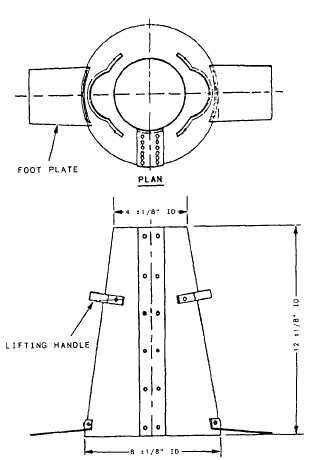Sampling Procedures
Sampling (or obtaining) concrete for the
slump test should be accomplished accord-
ing to ASTM C 172. In this TRAMAN, only
the procedure of sampling from a revolving
drum truck mixer (TM) or agitator is discussed.
If you should ever need to sample from a paving
mixer, open-top truck mixer, or other type of
equipment, be sure to refer to the most recent
ASTM C 172.
Samples taken for the test specimens must
be representative of the entire batch. This
is accomplished by taking the samples at two
or more regularly spaced intervals during dis-
charge of the middle portion of the batch.
Sample by repeatedly passing a scoop or pail
through the entire discharge stream. Composite
these samples into one sample for testing pur-
poses. Be sure that the first and last por-
tions of the composite sample are taken as
quickly as possible, but never exceeding 15
min. If it is necessary to transport the sam-
ples away from the mixer to the place where
the slump test is to be performed, combine the
samples and remix them with a shovel to ensure
uniformity.
Testing Procedures
Figure 15-40.-Slump cone.
to the
test load
is applied perpendicular
longitudinal axis of a standard size, premolded,
and-properly cured concrete beam. From this test,
the flexural strength, expressed in terms of
modulus of rupture and given in psi, can be
readily calculated. As with the compression test,
only the procedures to prepare the test beams cor-
rectly will be discussed in this TRAMAN.
SLUMP TESTS
The slump test is performed on newly mixed
concrete. To perform the test, you need a slump
cone and a tamping rod. The slump cone (fig.
15-40) should be made of galvanized steel, 12 in.
in height, with a base opening 8 in. in diameter
and the top opening 4 in. in diameter. Both the
top and bottom openings are perpendicular to the
vertical axis of the cone. The tamping rod is a
straight, steel rod that is 5/8 in. in diameter and
approximately 24 in. in length. One end of the
rod is rounded to a diameter of 5/8 in. (Do not
substitute a piece of rebar.)
Perform the slump test according to ASTM
C 143. Be sure to start the test within 5 min
after obtaining the final portion of the com-
posite sample. In performing the test, first
dampen the slump cone and place it on a flat,
moist, nonabsorbent, rigid surface. From the
composite sample obtained and while standing on
the two foot pieces of the cone, fill the cone in
three layers, each approximately one third of the
volume of the cone. In placing each scoopful of
concrete, rotate the scoop around the top edge
of the cone as the concrete slides from it to
ensure even distribution of concrete within the
mold.
Rod each layer with 25 strokes of the
tamping rod (using the rounded end), and
uniformly distribute the strokes over the en-
tire cross section of each layer. Rod the bottom
layer throughout its depth. Rod the second layer
and the top layer each throughout its depth so
that the strokes just penetrate into the under-
lying layer. In filling and rodding the top
layer, heap the concrete above the mold before
the rodding is started. If the rodding results
15-36

